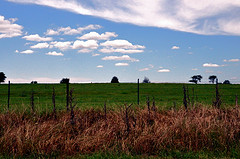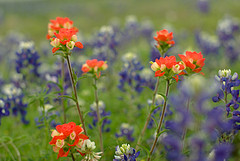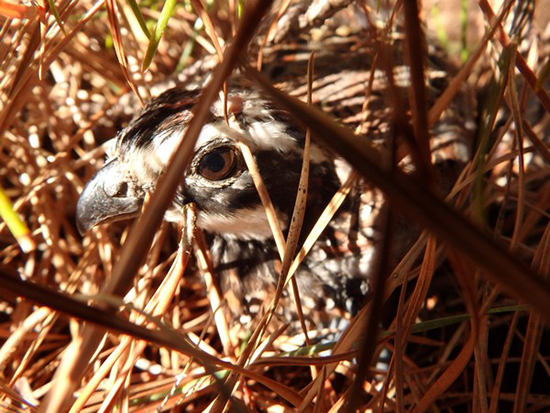Big News from Texas for Landowners and Little Birds
By: Amos S. Eno
Posted on:07/21/2010Private Landowner demand for services from the Texas Parks and Wildlife Department grows while federal support faces cutbacks
Texas means “big” in America: immense vistas, thundering cattle herds, 10 gallon hats, and lots of wildlife. But a state as big as Texas has absolutely no chance of achieving landscape-scale conservation without the cooperatio n of the “little guys.” By this I mean individual landowners, of acreages both large and small. The reason: Texas is 95% private.
n of the “little guys.” By this I mean individual landowners, of acreages both large and small. The reason: Texas is 95% private.
I recently had the pleasure of checking in with Carter Smith, executive director of the Texas Parks and Wildlife Department, or TPWD. My history with Texas goes back decades. Carter recalls that he had just graduated from college and come to work at TPWD when their phenomenally successful private lands program was in development. It took off with the help of a grant from NFWF in 1992, one of our largest ever at that time.
“When the program was developed, I had a chance to see it implemented,” said Carter.
“The early 90’s were a watershed time for the Department in fully embracing the significance of private land conservation.
What does the TPWD Private Lands Program do?
“At TPWD,” says Carter, “ one of our core and most important services is wildlife management, outreach and planning at no cost to participating landowners. All one has to do is contact one of our biologists. The biologist will make a site visit, talk to cooperating landowners about their habitat and wildlife specific goals, and prepare a written management plan with concrete recommendations for what they can accomplish.”
“In the last eight years we’ve
seen the number of acres under these plans increase from 8 to almost 27 million. Beginning in the mid-90s, there was a growing awareness among rural landowners that you could generate additional income by diversifying revenue streams, such as leasing land for recreational hunting. In some places there’s a real interest in other forms of nature tourism such as birding, weekend getaways, or agritourism.”
TPWD wildlife management plans serve many functions. In many ways, they are the “blueprint for keeping common species common.” They may also help landowners to qualify for a “wildlife management use valuation,” for property tax purposes, subject to certain practices, such as habitat management, water enhancement, population surveys and monitoring.
The Landscape Scale of Texas
Carte r reminded me that Texas has 11 distinct ecological regions, including portions of the southern great plains, the southern foothills of the Rockies found within the Chihuahuan Desert of west Texas, the Edwards Plateau in central Texas, timberland in the east, prairies and marshes along the Gulf Coast, and the Tamaulipan thornscrub in deep south Texas.
r reminded me that Texas has 11 distinct ecological regions, including portions of the southern great plains, the southern foothills of the Rockies found within the Chihuahuan Desert of west Texas, the Edwards Plateau in central Texas, timberland in the east, prairies and marshes along the Gulf Coast, and the Tamaulipan thornscrub in deep south Texas.
Grasslands are a big area of conservation emphasis, as they are in many other parts of the country. Landowners with suitable habitat and a large enough chunk of land can manage for species such as bobwhite quail, which are declining precipitously in the U.S. for a variety of complex and interconnected reasons. If done right, they’ll actually get huntable populations.
Carter truly believes that “the only way to accomplish landscape conservation is to work with private landowners in a meaningful way and on a meaningful scale for wildlife. In a state like Texas, it’s only through private lands that landscape conservation will happen. Red-cockaded Woodpeckers in longleaf pine stands and the Lesser Prairie Chicken in the grasslands of the panhandle are two examples of species completely dependent on private lands for their long-term survival.”
Around the time the Private Lands program was established, Wildlife Management Associations began to take off; now they number almost 180. “They bring neighbors together to focus on shared conservation goals, restoring the social and community fabric that we’re losing in rural America.”
A group of anywhere from a few to a few hundred landowners in a wildlife management association can work with TPWD to produce a wildlife management plan that will improve their property and qualify them for agricultural tax conversion. “They also enjoy coming together for meetings, dinners, and discussing issues, like managing for deer, how to control feral hogs or implement prescribed fire.”
A Push and a Pullback
Carter notes that there is now huge interest from private landowners in this program. “We have made this a major priority for the agency, and now demand for our biologists and management planning services is mushrooming. Candidly, it’s hard for us to keep up.”
At the same time that demand from private landowners is increasing, federal support for private lands is decreasing. “We lead the nation in amount of farm and ranch land lost every year to development,” says Carter. “By 2012 all four million acres enrolled in CRP will be up for renewal. Due to a variety of changes in federal farm policy and incentives, a fair amount of that acreage will not get reenrolled, but enrollment has huge incidental benefits to wildlife. Some species, like the Lesser Prairie Chicken, actually need more acreage enrolled, not less.”
Another concern: In the past several decades, “we’ve witnessed the single largest divestiture of private lands in Texas: the large timber companies have sold out to TIMO’s,” or Timber Investment Management Organizations. “These TIMO’s typically operate with a 10 year fund life, and their large institutional investors are expecting specific rates of return. As such, their time and profit horizons are very different from historic timber companies that managed for a range of values over the long term,” says Carter. "For example, with TIMOs, there are no long term set asides for conservation purposes, and it can be difficult for us to compete financially to lease long term public hunting lands."
As I am reminde d again and again, private landowners need their land for income, but usually they want more. That’s another reason they’re so important. Carter recalls one Lone Star Land Steward, the winner of a program recognizing exemplary stewardship sponsored by TPWD and the Aldo Leopold Foundation. He told me, “The guy who received one of the awards said that it was one of the happiest days of his life when he first began to hear the call of the quail again.”
d again and again, private landowners need their land for income, but usually they want more. That’s another reason they’re so important. Carter recalls one Lone Star Land Steward, the winner of a program recognizing exemplary stewardship sponsored by TPWD and the Aldo Leopold Foundation. He told me, “The guy who received one of the awards said that it was one of the happiest days of his life when he first began to hear the call of the quail again.”
 Sign In
Sign In
 Sign In
Sign In
